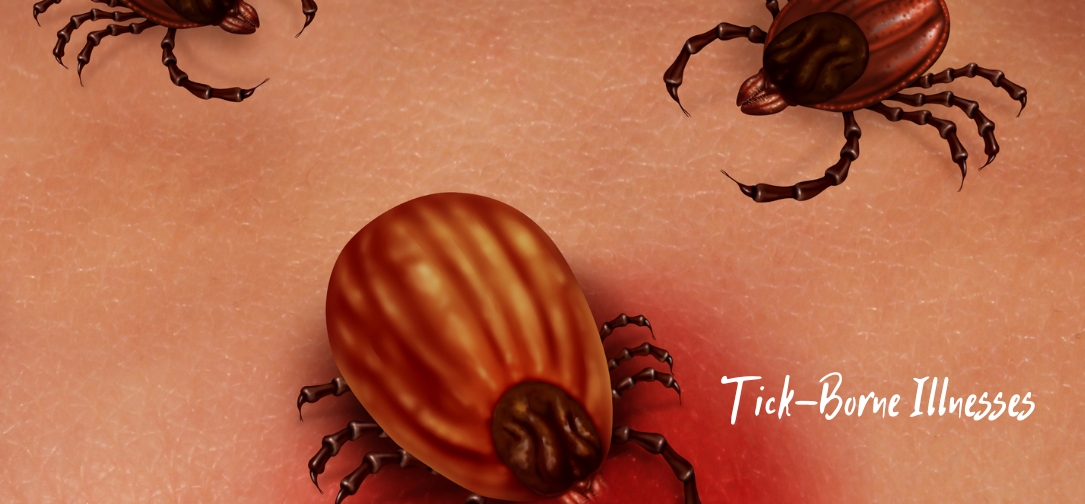Public Health
Lyme Disease: The Rising Threat of Tick-Borne Illnesses

Tick-borne illnesses, particularly Lyme disease, are emerging as a significant public health concern worldwide. These diseases, transmitted primarily by ticks, have surged in prevalence over the past few decades, drawing increasing attention from medical researchers, public health officials, and the general public. Lyme disease, the most common tick-borne illness, stands at the forefront of this growing epidemic. This article explores Lyme disease in detail: its origins, symptoms, challenges in diagnosis and treatment, the increasing threat it poses, and the ongoing efforts to combat it.
1) What is Lyme Disease?
Lyme disease is a bacterial infection caused by the spirochete bacterium Borrelia burgdorferi and, less commonly, Borrelia mayonii. Named after the town of Lyme, Connecticut, where a cluster of cases was first identified in the 1970s, Lyme disease is primarily transmitted to humans through the bite of infected black-legged ticks, also known as deer ticks (Ixodes scapularis) in the United States and the castor bean tick (Ixodes ricinus) in Europe. These ticks acquire the bacteria by feeding on infected hosts such as rodents, birds, and deer, making them effective vectors for disease transmission.
2) The Global Spread and Rising Prevalence
Initially considered a regional concern in parts of the northeastern United States, Lyme disease has since spread to become a global issue. Lyme disease cases have been reported across North America, Europe, and parts of Asia. The Centers for Disease Control and Prevention (CDC) estimates that about 476,000 Americans are diagnosed and treated for Lyme disease each year, a dramatic increase from previous decades. Similarly, tens of thousands of new cases are reported annually in Europe, with the highest incidence observed in Central and Northern Europe.
Several factors contribute to this rising prevalence. Climate change is a significant driver, as milder winters and longer summers expand the range and increase the activity period of ticks. Additionally, increased human encroachment into wooded and rural areas and greater outdoor recreational activities have heightened the likelihood of human-tick encounters. Changes in land use, such as suburban development and reforestation, have also provided ideal habitats for ticks and their host species.
3) The Biology and Life Cycle of Ticks: Understanding the Vector
Ticks, small arachnids closely related to spiders, have a complex life cycle that involves four stages: egg, larva, nymph, and adult. This life cycle can span two to three years, depending on environmental conditions. Each stage requires a blood meal from a host to progress to the next, making ticks efficient vectors for various pathogens.
The black-legged tick, which transmits Lyme disease, is most dangerous in its nymphal stage. Nymphs are about the size of a poppy seed, making them extremely difficult to detect. Since they are most active during late spring and early summer, these seasons correspond with the peak of Lyme disease transmission.
4) Symptoms and Stages of Lyme Disease
The clinical manifestation of Lyme disease can be highly variable, ranging from mild symptoms to severe, long-lasting health problems. It is typically divided into three stages:
Early Localized Stage:
Within 3 to 30 days after a tick bite, individuals may develop an erythema migrans (EM) rash, often described as a “bull’s-eye” rash due to its red, circular appearance with a clear center. The rash may expand over time and is usually not painful or itchy. Approximately 70-80% of infected individuals develop this hallmark rash. Other early symptoms may include fever, chills, headache, fatigue, muscle and joint aches, and swollen lymph nodes.
Early Disseminated Stage:
If untreated, the infection can spread to other parts of the body within weeks to months after the initial tick bite. This stage may present with multiple EM rashes on different parts of the body, along with neurological symptoms such as facial palsy (loss of muscle tone or droop on one or both sides of the face), meningitis (severe headaches and neck stiffness), and radiculoneuropathy (pain that radiates from the spine). Cardiac manifestations, such as Lyme carditis, may also occur, leading to palpitations, dizziness, and even heart block in severe cases.
Late Disseminated Stage:
Months to years after infection, if Lyme disease remains untreated, it can lead to severe, chronic symptoms. Patients may develop Lyme arthritis, characterized by severe joint pain and swelling, particularly in the knees. Neurological problems, such as peripheral neuropathy and cognitive impairments, also become more common in this stage. This chronic phase of the disease, often referred to as “post-treatment Lyme disease syndrome” (PTLDS), can severely impact the quality of life.
5) Diagnostic Challenges and Controversies
One of the biggest challenges in managing Lyme disease is accurate and timely diagnosis. The disease is often called “The Great Imitator” because its symptoms can mimic those of other conditions, such as chronic fatigue syndrome, fibromyalgia, multiple sclerosis, and rheumatoid arthritis.
Current Diagnostic Methods:
The standard diagnostic approach involves a two-tiered blood test: an enzyme-linked immunosorbent assay (ELISA) followed by a Western blot test for confirmation. However, these tests have limitations. They are most accurate in the later stages of the disease when antibodies have reached detectable levels but are less reliable in the early stages. False negatives are common if testing is done too early, while false positives can occur due to cross-reactivity with other infections.
Controversies and Emerging Diagnostics:
The lack of a definitive, highly sensitive test for early Lyme disease has fueled debate in the medical community. Some practitioners advocate for clinical diagnosis based on symptoms and history, while others call for more research into new diagnostic tools, such as direct detection of Borrelia DNA in blood or skin biopsies, or advanced imaging techniques to detect early dissemination. Emerging technologies like CRISPR-based diagnostics and nanotechnology are also being explored for their potential to revolutionize Lyme disease detection.
6) Treatment Protocols and the Debate Over Chronic Lyme Disease
Standard Treatment Approaches:
The standard treatment for Lyme disease involves antibiotics, such as doxycycline, amoxicillin, or cefuroxime axetil, taken for two to four weeks. Early intervention with antibiotics is typically effective in resolving symptoms and preventing progression to later stages. For patients with neurological or cardiac involvement, intravenous antibiotics like ceftriaxone may be required.
The Debate Over Chronic Lyme Disease:
The existence of “chronic Lyme disease,” also known as post-treatment Lyme disease syndrome (PTLDS), is highly controversial. Some patients continue to experience debilitating symptoms such as fatigue, joint pain, and cognitive difficulties even after standard antibiotic treatment. The cause of these persistent symptoms is debated; some experts believe they result from lingering inflammation or immune dysfunction rather than active infection. Others argue for the possibility of persistent infection and advocate for prolonged antibiotic treatment.
This debate has significant implications for patients, many of whom struggle to find effective care and face skepticism from healthcare providers. More research is needed to better understand the mechanisms underlying PTLDS and to develop effective treatment strategies.
7) Prevention: The Best Defense Against Lyme Disease
Given the challenges of diagnosing and treating Lyme disease, prevention is crucial. Reducing the risk of tick bites is the most effective strategy for preventing Lyme disease and other tick-borne illnesses. Key prevention measures include:
- Avoiding Tick-Infested Areas: When possible, avoid areas with high grass, leaf litter, and dense vegetation where ticks are commonly found, especially during peak activity seasons.
- Using Insect Repellents: Repellents containing DEET, picaridin, IR3535, or oil of lemon eucalyptus can reduce the risk of tick bites.
- Wearing Protective Clothing: Long sleeves, pants, and socks provide a physical barrier to ticks. Light-colored clothing can help detect ticks more easily.
- Performing Tick Checks: After spending time outdoors, perform thorough tick checks on yourself, your children, and your pets. Pay special attention to hard-to-see areas such as the scalp, behind the ears, and between skin folds.
- Prompt Tick Removal: If a tick is found attached, remove it promptly with fine-tipped tweezers by grasping it close to the skin and pulling upward with steady, even pressure. Early removal can significantly reduce the risk of infection.
- Landscaping and Yard Management: Keeping lawns mowed, removing leaf litter, and creating tick-free zones with mulch or gravel can help reduce tick populations around homes.
8) Vaccines and Innovative Research: A Glimmer of Hope
The development of a Lyme disease vaccine has been a subject of significant research interest. In the late 1990s, a vaccine called LYMErix was approved by the U.S. Food and Drug Administration (FDA). However, it was withdrawn from the market in 2002 due to low demand and concerns about side effects. Recently, renewed efforts have emerged to develop a safe and effective Lyme vaccine. The leading candidate, VLA15, developed by Valneva and Pfizer, is currently in advanced clinical trials and has shown promise in providing protective immunity against multiple strains of Borrelia.
In addition to vaccines, researchers are exploring other innovative strategies, such as tick-targeted interventions (e.g., genetically engineered ticks or tick pheromone traps) and microbiome-based approaches to prevent Borrelia colonization in ticks.
9) The Broader Implications: Beyond Lyme Disease
While Lyme disease is the most well-known tick-borne illness, ticks can transmit numerous other pathogens, including the bacteria causing anaplasmosis and ehrlichiosis, the protozoan responsible for babesiosis, and viruses like the Powassan virus. Co-infections with multiple pathogens can complicate diagnosis, treatment, and recovery. The rise of Lyme disease is indicative of a broader trend: the increasing threat of vector-borne diseases in a rapidly changing world. Climate change, global travel, deforestation, and changing ecosystems are all contributing to the expansion of tick populations and the pathogens they carry.
Conclusion: A Call to Action
Lyme disease and other tick-borne illnesses are rising threats that require urgent attention and action from the medical community, researchers, policymakers, and the general public. The challenges of diagnosis, treatment, and prevention highlight the need for a comprehensive, multi-faceted approach to combat these diseases.
-

 Business5 days ago
Business5 days agoS&P 500 Soars in Best May in Decades Amid Tariff Relief and Nvidia’s Surge
-

 Healthcare6 days ago
Healthcare6 days agoAttention Economy Arms Race: Reclaim Your Focus in a World Designed to Distract You
-

 Immigration5 days ago
Immigration5 days agoTrump’s Immigration Crackdown: Legal Battles and Policy Shifts
-

 Business5 days ago
Business5 days agoUS Stock Market Soars in May Amidst Tariff Tensions and Inflation Worries
-

 Government5 days ago
Government5 days agoTrump Administration’s Government Reshaping Efforts Face Criticism and Legal Battles
-

 Business5 days ago
Business5 days agoTrump’s Tariffs: A Global Economic Reckoning
-

 Foreign Policy2 days ago
Foreign Policy2 days agoInside Schedule F: Will Trump’s Federal Workforce Shake-Up Undermine Democracy?
-

 Press Release2 days ago
Press Release2 days agoIn2space Launches Campaign to Make Space Travel Accessible for All




























